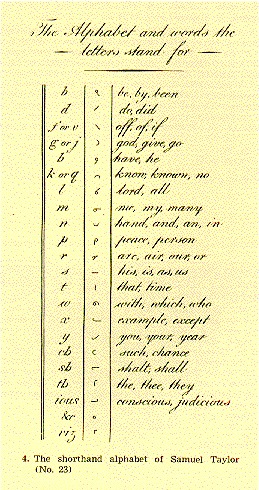Shorthand
SAMUEL TAYLOR (fl. 1786)
An Essay intended to Establish a Standard for an Universal System of Stenography.
London, The Author, 1786.
This is the first edition, first issue of Taylor's work, perhaps one of the most influential in the field of stenography. Like that of John Byrom, whose Universal English Short-Handappeared in 1767, Taylor's system is noted for its brevity. It consists of only a consonantal alphabet of nineteen letters and a few abbreviating rules. Many later editions appeared, the most important being that edited by William Harding in 1823. Taylor's work established the art of stenography in England, and his system came into general use on the continent and in the United States. This copy bears the author's autograph signature, together with the bookplate of Charles Bathurst. (Alston VIII:286; Galland p. 179; NYP 38:51; Westby-Gibson p. 215)
NOAH BRIDGES (fl. 1659?-1661)
Stenographie and Cryptographie.
[sic]. London, The Author, 1659.
Stenographer and mathematician, Noah Bridges was a royalist supporter of King Charles I. HisStenographie is a practical work on shorthand and secret writing. Bridges' system is the first to make extensive use of dots rather than alphabetic symbols to represent initial and final vowels. A much expanded second edition appeared in 1662. The work was brought out again in 1665 with 22 pages of additional material under the title: Rarities; or, The Incomparable Curiosities in Secret Writing Explained. (Alston VIII:104; Carlton (Pepys) p.74; Galland p. 29; Stojan 477; Westby-Gibson p. 29; Wing B4482)
PIERRE CARPENTIER (1697-1767)
Alphabetum Tironianum, seu Notas Tironis Explicandi Methodus.
Paris, Hippolyte-Louis Guerin, & Jacques Guerin, 1747.
Carpentier's work is an early attempt to explain the cipherment and decipherment of Tironian notes, said to have been invented by M. Tullius Tiro, freedman of Cicero. One of the earliest forms of shorthand, Tironian notes utilize a tachygraphic system, that is, one in which the alphabetic characters used have an ideographic value. One of its features, that of employing initial letters to represent words, is still in use today, as, for example, the use of "A.D." for "Anno Domini" and "N.B." for "Nota bene." Carpentier devotes considerable attention to the Latin manuscript number 2718 at the Bibliothèque Nationale, Paris. His work has been largely discredited by later studies. (Galland p. 36; Graesse II:54; NYP 38:685; Westby-Gibson p. 38)
JEAN FELICITE COULON DE THEVENOT (1754-1813)
L'art d'Ecrire aussi Vite qu'on Parle. Dix-neuvième édition.
Paris, L'Auteur, 1795.
Originally published in 1777, Coulon de Thévenot here presents the first shorthand system of significance invented in France. His system is noted for disjoining vowels from consonants. The work saw numerous editions. The present edition represents revisions made by the author in 1786 and 1787. While generally shorthand books of this period were printed from engraved plates, this edition of Coulon de Thévenot has the symbols and characters used inserted by hand. (Galland p.48; Guyot p.438)
FRANCISCO DE PAULA MARTI (1762-1827)
Tachigrafía de la lengua Castellana.
Barcelona, Imprenta de Augustin Roca, 1816.
The father of Spanish stenography, Francisco Martí first published his shorthand system in 1803. His alphabet is a combination of those of Coulon de Thévenot and Samuel Taylor. Martí's method became the basis of several later shorthand systems, including that of Fancisco Serra y Ginesta (1816). His work also enjoyed the support of the Spanish Government, which on November 21st, 1802, set up a public professorship of shorthand at Madrid. Martí became the first to hold this position. (Palau 8:237; Westby-Gibson p. 124)
WILLIAM MASON (fl. 1672-1709)
La Plume Volante.
London, D. Brown [etc.] 1707.
The most important English stenographer of the seventeenth century, Mason produced three works on shorthand of which La Plume Volante is the last. Mason derives part of his system from that of Jeremiah Rich, published in 1646. He employs alphabetic signs, symbols, and arbitraries. Mason's system is the first to make use of a small circle for "s" in addition to its alphabetic sign. His work was re-issued by Thomas Gurney in 1740. Gurney's own position as shorthand writer of the Central Criminal Court in London secured the perpetuation of Mason's shorthand method to the present day. This copy of La Plume Volante bears the bookplate of Hugh Cecil, 5th Earl of Lonsdale (d. 1944). (Alston VIII: 168; Carlton (Pepys) p. 82; NYP 38:35; Westby-Gibson p.126)
CHARLES ALOYSIUS RAMSAY (fl. 1670-1689)
Tacheographia, seu Ars Celeriter & Compendiosè quaelibet inter Perorandum Verba.
Paris, 1683.
Originally published at Frankfurt am Main in 1678, this title is considered the earliest independent German manual on stenography. This Paris edition of 1683 includes both Latin and French versions on parallel pages. Ramsay's work is a slight modification of the system proposed in Thomas Shelton'sTachygraphy (London, 1635), known chiefly at the present time for its use by Samuel Pepys (1633-1703) in writing his Diary. The French version exhibits the greatest divergence from Shelton's method, including the adoption of simple signs for several alphanumeric characters. Tacheographiaincludes an appendix on processes of cipherment. (Carlton (Pepys) p. 118; Galland p. 153; NYP 38:38; Westby-Gibson p. 184)
